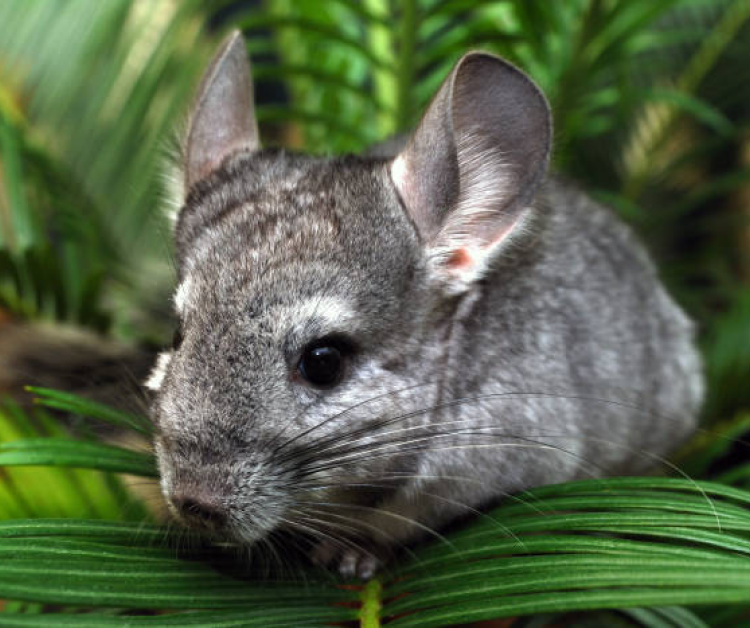
Chinchilla: A Recently Introduced Species in Moldova
Chinchillas, a species recently introduced to the fur farming sector in the Republic of Moldova, are increasingly appreciated for their exceptionally fine fur and their diet, which consists exclusively of plant-based feed. This species is known for its resilience, minimal requirements, and adaptability to both rural and urban environments. Thanks to their gentle behavior and pleasant appearance, chinchillas are valued both commercially and as pets, being ideal for apartment living due to their lack of unpleasant odors and minimal space requirements.
In Moldova, the chinchilla industry has experienced significant growth, driven by the demand for high-quality fur and the increasing interest in exotic pets. Investing in a chinchilla farm represents a promising business opportunity, with a quick return on investment, often within the first year of activity, due to high profit margins. This industry offers a viable economic opportunity supported by local and international market demands, contributing to the development of the agricultural sector and the diversification of Moldova's economy.
Chinchilla Overview
The chinchilla is a mammal from the rodent family, native to the mountainous regions of South America, including Argentina, Bolivia, and Chile. It lives at altitudes of up to 3,000 meters in extreme conditions of temperature and low humidity, which enable it to endure long periods without water. As a herbivore, the chinchilla feeds in the wild on grasses, seeds, roots, and leaves.
The taxonomic classification of the chinchilla is as follows:
- Class: Mammalia
- Subclass: Theria
- Group: Eutheria
- Order: Rodentia
- Suborder: Hystricomorpha
- Family: Chinchillidae
- Genus: Chinchilla
History of Captive Breeding
The foundation of chinchilla captive breeding was laid by Mathias Ferrel Chapman, an American mining engineer in the Andes. Fascinated by this animal, Chapman obtained permission to bring a group of 11 chinchillas to the United States, establishing the first chinchilla farm in California. Later, chinchillas arrived in Europe thanks to a German fur trader who introduced the species to the European continent, establishing a genetic base that allowed their spread throughout the region.
Characteristics and Economic Value
Chinchillas are renowned for their dense, fine fur, with each hair being approximately 200 times thinner than a human hair, giving it a unique and valuable texture. This exceptional density prevents the fur from parting when touched.
In the Republic of Moldova, chinchillas are valued both for their fur and for the economic potential offered by captive breeding. Chinchilla farming offers profit opportunities through the sale of high-quality fur, used in the fashion industry, and through the utilization of chinchilla meat as feed for other valuable fur animals.
Chinchillas are nocturnal, gentle, and adaptable animals, easy to raise in captivity and low-maintenance. They are docile and non-aggressive, making them pleasant pets. However, when stressed, chinchillas can release an almond-like scent and shed fur, which regenerates slowly, impacting its commercial value. Therefore, handling these animals requires a gentle and careful approach.
The name "chinchilla" derives from the "Chincha" tribe of South America, encountered by Spanish conquistadors in the 16th century. This elegant and adaptable animal is considered a jewel of South American fauna, continuing to fascinate breeders and the public alike.
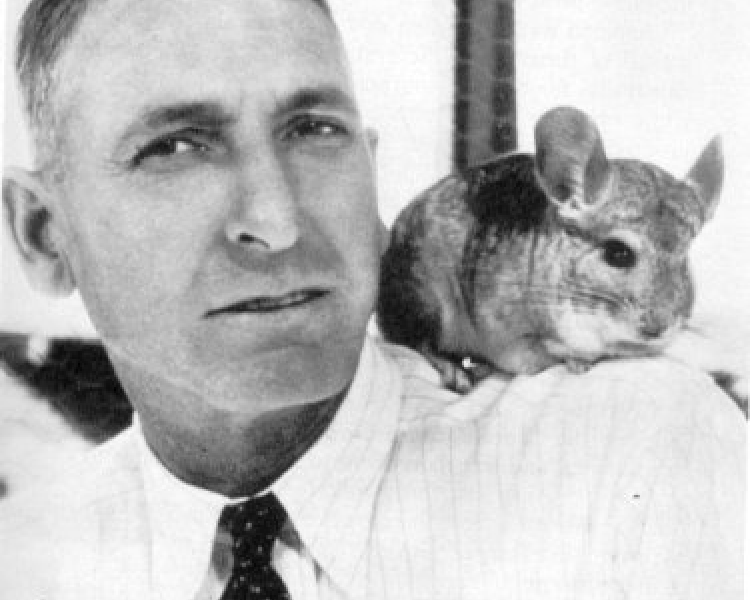
Appearance and Behavior of Chinchillas
In appearance, the chinchilla resembles a combination of a squirrel and a rabbit. Adult weight ranges between 400 and 600 grams, and the body length reaches 28-30 cm, with females being slightly larger than males. It has a small head, a slightly pointed snout, large black eyes, and ears approximately 6 cm long, covered with fine fur. The tail is long and curved, while the front limbs are small, with five fingers ideal for handling food. The hind limbs are longer and have four toes, allowing the chinchilla to sit in upright positions.
The fur is exceptionally fine and dense, considered the most valuable aspect of this animal. Each hair is approximately 200 times thinner in diameter than a human hair, and each follicle can contain between 70 and 120 hairs, with lengths of up to 2.5 cm. This extreme density makes chinchilla fur particularly prized and valuable.
Although chinchillas originate from the wild, captivity has transformed them into gentle and sociable animals. They are resilient and have the ability to hide symptoms of certain illnesses. Chinchillas rarely bite, only when they feel threatened, and are not prone to escaping. They are extremely curious and tend to gnaw on objects around them. Being exceptionally clean animals, chinchillas "bathe" daily in special sand, which helps them maintain their fur in optimal condition.
Due to their resilient and gentle nature, chinchillas are a popular choice both for the fur industry and as pets. They are relatively easy to care for and particularly friendly with people.
Main Body Regions in Chinchillas

- Head Region – includes the head, muzzle, and ears.
- Neck Region – the area between the head and chest.
- Chest Region – the front part of the body, in the thoracic area.
- Back Region – the upper part of the back.
- Rump Region – the back part of the body.
- Flank Region – the sides of the body.
- Abdominal Region – the lower part of the body.
- Tail – the long, curved tail of the chinchilla.
Types and Colors
There are two recognized types of chinchillas, the most common in breeding farms being:
Chinchilla Laniger – This is the most frequently encountered type in breeding farms. Its fur is light gray with a silvery hue on the back and off-white on the abdomen. The fur color is determined by the three-zone structure of the hair: light gray at the base, yellowish-white in the middle, and black at the tip. This combination creates the fine and elegant appearance characteristic of Chinchilla Laniger fur.
Chinchilla Brevicaudata
Chinchilla Brevicaudata is slightly larger in size than Chinchilla Laniger and exhibits a distinctive coloration, predominantly bluish-gray on the back. This shade is the result of the combination of the three sections of the hair: bluish-gray at the base, gray-yellowish in the middle, and dark bluish at the tip. Due to this uneven coloration, Chinchilla Brevicaudata is less common in breeding farms, being considered rarer and more challenging to maintain for achieving uniform fur.
Color Varieties of Chinchilla Fur
Due to selective breeding and modern farming practices, chinchillas have developed a wide range of fur colors that are highly valued in the industry. Here are some of the most common color varieties of chinchilla fur:
- A. Dark Ebony
- B. Light Ebony
- C. Light Beige
- D. Medium Beige
- E. Dark Beige
- F. Medium Touch of Velvet
- G. Dark Touch of Velvet
- H. White
- I. Silver
- J. Medium Standard
- K. Dark Standard
- L. X-Dark Standard
- M. XX-Dark Standard
- N. Light Black Velvet
- O. Medium Black Velvet
- P. Dark Black Velvet
These varieties have been developed through rigorous selection processes, offering a range of shades and textures that meet the diverse demands of the fur market and chinchilla enthusiasts as pets.
Chinchilla Fur
Chinchilla fur is extremely valuable, with costs reaching up to €10,000 for high-quality products. Each square centimeter of fur is considered precious due to its fineness and density. Fur maturity is reached at around 8-9 months of age and can be classified into three main stages:
- Puppy Fur: Characterized by sparse, growing hairs.
- Young Fur: Appears around 5 months after birth when the hairs have reached their mature length.
- Mature Fur: The hairs have a uniform length, and the animal's skin turns white, indicating the fur has reached its peak quality.
After the maturity stage, hairs may begin to shed, and the skin color changes from white to light blue, indicating the onset of over-maturity. Following this stage, a new fur growth cycle begins, lasting approximately 4 months.
Structure and Color of the Fur
The fur begins to develop during the intrauterine period, so pups are born already covered with fur. It consists of two types of hair: undercoat and guard hairs. Typically, the undercoat exhibits a three-color structure from tip to root:
- Blue or black at the tip,
- White or pale blue in the middle,
- Blue at the base.
Any variation from these standard colors is considered a defect, and animals exhibiting such variations are not kept for breeding but are culled.
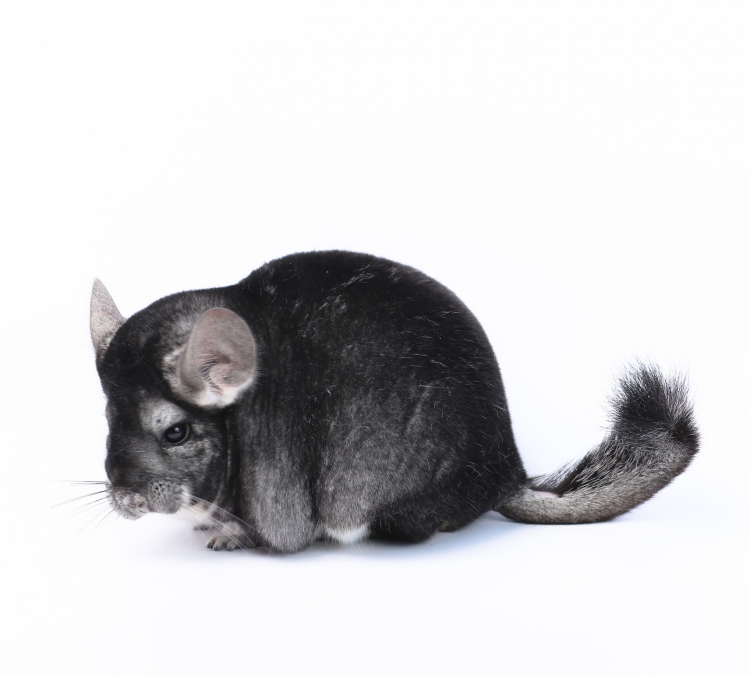
Color Zones of the Fur
The chinchilla's undercoat develops on the sides of the body and the back, and its color is structured into three zones:
- Veil – the outer layer of the fur,
- Band – the middle zone of the color,
- Undercolor – the color at the root.
On the abdomen, the undercoat displays a specific coloration, with a dark blue root and a white tip. The guard hair, which is longer and thicker than the undercoat, complements the unique texture of chinchilla fur.
To evaluate the quality of chinchilla fur, breeders consider a series of specific factors, each having a direct impact on its commercial value. Here are the main quality indicators and defects that can affect the fur:
The size of the fur influences its commercial value, reaching its optimal dimensions at the animal's maturity. Specimens with a cylindrical trunk, broad shoulders, and a short, thick neck are preferred for high-quality fur.
The sheen is determined by the structure of the scaly layer and the secretion of sebaceous glands. During the cold season, the fur has a more pronounced sheen, as lower temperatures enhance this characteristic.
The texture is determined by the condition of the hairs, which should be fine, elastic, and dense. If the fur is coarse and lacks elasticity, resembling a "hemp-like" texture, it is considered defective. The presence of such specimens can pose a risk to the rest of the community and requires their removal.
The fur color is essential in determining its commercial value. Standard chinchillas display a variety of shades, ranging from pale to nearly black. The five levels of color are:
- Dark
- Medium-Dark
- Medium
- Medium-Light
- Light
Elasticity is reflected in the ability of the hairs to return to their original shape after being stroked. Elastic fur immediately returns to its original shape and is considered of superior quality.
The fineness of fur is measured in microns and reflects the resistance of hairs to touch. The undercoat has a thickness between 2 and 6 microns, while guard hairs range from 10 to 16 microns. The finer the hairs, the higher the quality of the fur.
Density is assessed by touch or visually. High density gives the fur a darker color. If you "blow" over the fur and see only a small portion of the animal's skin, the density is considered high.
Conclusion.
The quality of fur is superior in mature animals, as the fur of juveniles or young offspring is considered inferior. The qualitative characteristics of fur are genetically transmitted, so only specimens that meet quality standards are selected for breeding. Fur quality is also influenced by the season, with the best furs obtained in winter, while in spring, the quality decreases.
Defects in Chinchilla Fur
Chinchilla fur can exhibit defects that reduce its commercial value, caused by improper care, environmental conditions, or dietary deficiencies:
- Nipped fur: Caused by damaged cages or entanglement in wires or nails.
- Discoloration: Occurs due to prolonged exposure to sunlight.
- Bite marks: Resulting from conflicts between chinchillas, especially during mating.
- Hair loss: Caused by nutritional deficiencies or improper conditions during slaughter and storage.
- Matted fur: Characterized by tangled hairs, reduced strength, and decreased undercoat density. This occurs due to inadequate feeding or care. Such specimens are not used for breeding.
- Sticky fur: Caused by dirt, secretions, or contact with feces and urine. It indicates poor cage hygiene and inadequate care.
Adhering to these quality standards and eliminating factors that lead to defects contribute to maintaining a healthy population and producing high-quality fur that is valued in international markets.
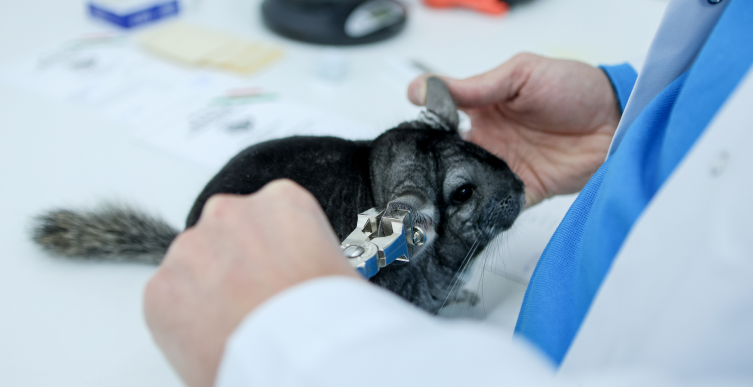
Shelters for Chinchillas
Chinchilla shelters are relatively simple and adaptable, much like the chinchilla itself, an animal with minimal environmental demands. Depending on the temperature, chinchillas can be raised in wire mesh enclosures with cages placed directly on the ground. In warmer regions, sheds can be used, while in colder areas, shelters are constructed from materials like brick, thin concrete, or even wood. The essential condition is that the shelter remains clean, dry, and free from drafts.
Comfort and Hygiene Factors
Ideally, chinchilla shelters should be quiet and insulated from loud noises. A calm space contributes to the animals' well-being, as they are sensitive to noise. The interior of the shelters should be finished to facilitate cleaning. Walls, ceilings, and floors should be smooth and free of cracks to prevent dust accumulation and drafts. Concrete floors can be covered with linoleum to reduce noise from footsteps.
Optimal Temperature and Humidity Conditions
Chinchillas prefer cooler temperatures over warmer ones. Temperatures above 25°C can cause respiratory issues, and at over 30°C, there is a risk of mortality. The ideal temperature for chinchilla shelters ranges from 13-18°C. During birthing periods and in the first few weeks of the pups' lives, a higher temperature, close to 18°C, is recommended to protect the sensitive pups. At temperatures below 12°C, pups are at risk, and male virility decreases. During the slaughtering process, animals are kept at lower temperatures, between 3 and 8°C. The optimal relative humidity is around 70%.
Chinchilla Shelters
Chinchilla shelters do not require significant investments in specially designed buildings. It is recommended to use existing structures such as sheds, storage spaces, or aviaries to reduce initial costs. The roofs of the shelters can be made of materials like corrugated metal sheets, asbestos cement, or tar paper. Central heating systems are useful only for fine temperature adjustments and should be used to avoid sudden temperature changes, which are harmful to chinchillas.
Avoiding Drafts and High Humidity
A fundamental rule of microclimate management is avoiding drafts, as chinchillas are extremely sensitive to them. Shelters must be well-insulated to prevent animals from falling ill. Excessive humidity reduces appetite, increases the risk of diseases, and promotes food spoilage and mold growth.
Arrangement of Cages and Access for Care
Chinchilla cages are small and can be arranged in tiers using racks or shelves. Shelters do not need to be large, as chinchillas live in compact cages. There is no specific optimal number of animals per square meter, as conditions vary depending on the type of shelter. It is essential to ensure adequate space between cages, allowing caretakers to easily observe and access the animals. These recommendations ensure an optimal environment for raising chinchillas, maintaining a balance between costs, microclimate conditions, and the specific needs of this valuable animal.

Chinchilla Cages
Chinchilla cages are made from wire mesh with a diameter of 1-1.5 mm. The mesh size varies depending on its purpose:
- Flooring: 13x25 mm mesh size;
- Walls: 19x19 mm mesh size;
- For breeders, juveniles, and animals intended for slaughter: 25x25 mm mesh size.
In breeding facilities, two main types of cages are used:
- Cages for juveniles and animals intended for slaughter
- Cages for breeders
Cages for juveniles and animals intended for slaughter have standard dimensions of 40x40x40 cm. While not mandatory, these dimensions are recommended for efficiency. Although some specialists discourage stacking cages, arguing that animals require close observation, cages can still be stacked in 4-5 levels, optimizing space and allowing for the raising of 80-90 chinchillas on a 10 m² area.
Cages for breeders are partitioned, with a central corridor allowing males access to multiple compartments where females are kept. The dimensions of these cages range from 80-140 x 80 x 40 cm, depending on the number of compartments. Each compartment includes openings for male movement, while females are prevented from leaving their compartments using collars larger than the openings.
Cage Features and Design
The cage includes:
- A door on the front wall,
- A trough for concentrated feed,
- A trough for fibrous feed,
- A water bottle with a drinking nozzle or a centralized watering system.
Chinchillas require a daily "sand bath" to maintain clean fur. This is done in a special box attached to the cage wall, and the sand must be replaced periodically. The sand used should be fine and quartz-free to avoid scratching the fur. A chinchilla's refusal to bathe in sand may indicate health issues.


Commercial Considerations and Practical Aspects
Chinchilla farming can be a profitable business, but it is important to consider challenges such as:
- The need for constant care,
- Careful selection of valuable specimens,
- Health monitoring and disease prevention.
The price of chinchillas ranges between €60 and €200, depending on fur quality, making this business attractive for breeders with limited space. However, special attention must be given to the maintenance and health of the animals to ensure superior fur quality and maximum profit.
Building Large-Scale Chinchilla Farms (Intensive Breeding)
To establish a large-scale chinchilla farm with thousands of specimens, a spacious hall is required, adhering to all the requirements and rules of smaller farms but on a much larger scale. Proper planning of space and infrastructure becomes essential to ensure operational efficiency and animal welfare.
Main Feed
1. Hay
Hay is essential for chinchilla digestion, providing fiber and maintaining intestinal balance. The characteristics of high-quality hay include:
- Harvested on dry, rain-free days,
- Dried in the shade to retain its green color,
- Pleasant smell and free of toxic plants.
Hay should be stored in a ventilated space, protected from dust and moisture, and turned regularly to prevent mold. Alfalfa or clover hay is preferred, while grass hay is considered superior due to its resistance to fermentation and mold. Chinchillas also consume bean or pea stalks, which are a welcome addition to their diet.
2. Concentrates
Concentrates are provided in the form of grains, including oats, barley, corn, and wheat. The quantity administered depends on the development stage and the animal's needs; pregnant females and young chinchillas consume more concentrates (15-30 grams daily).
Recently, pelleted feeds have become increasingly common. These are prepared according to specific recipes and available in various pellet sizes (2-12 mm). Chinchillas consume at their discretion, with more substantial feed provided for lactating females and growing young chinchillas.
Watering
Chinchillas require approximately 80 ml of water per day to compensate for the dry feed and concentrated fodder they consume. The water must be drinkable, colorless, tasteless, odorless, and free of microorganisms or pathogenic germs, ideally at a temperature of 15°C.
Potable water can come from tap water (free of chlorine or iron salts) or wells, but water from wells should be tested periodically to prevent contamination with harmful germs.
Watering chinchillas is an essential aspect of their care, which can be done through two main methods:
-
Bottle feeders
These are mounted upside down on the walls of the cage, providing chinchillas with easy access to fresh water. Bottle feeders are hygienic and reduce the risk of water contamination with feed particles or dirt. -
Watering troughs
These are a practical alternative, ensuring a constant source of water. Troughs are ideal for large farms, where simultaneously managing the water supply for multiple animals is a priority.
Chinchilla Breeding
Raising chinchillas is an activity that requires professionalism and careful planning. Breeding plays an essential role in obtaining healthy specimens with superior-quality fur and involves adhering to clear principles.
Reproductive Maturity and Mating
Chinchillas reach reproductive maturity between 7 and 9 months, but the first mating is recommended at 10 months for females and 12 months for males. The optimal mating period is between December and February, when conditions are favorable. It is essential to avoid mating females younger than 8 months and immature males to prevent the birth of weak offspring with low survival chances.
Reproductive Longevity
Chinchillas can reproduce until the age of 15 years, offering breeders the opportunity to maintain stable genetic lines and high-quality specimens.
Gestation and Birth
Gestation lasts approximately 111 days, and the female can give birth to 1-5 kits, with an average of 2-3 kits per litter. Signs of pregnancy include gradual weight gain, abdominal changes, and mammary gland development. At birth, the female removes the membranes and cuts the umbilical cord. The kits are covered in fur and open their eyes immediately.
Kit Feeding
The kits are exclusively fed with the mother’s milk until one month of age, after which they gradually transition to a balanced diet based on special feed, ensuring healthy and vigorous growth.
Recommendations for Success
Select healthy pairs and avoid overburdening females by limiting reproduction to 2-3 times per year. Provide an adequate environment, high-quality nutrition, and constantly monitor the health of the animals.
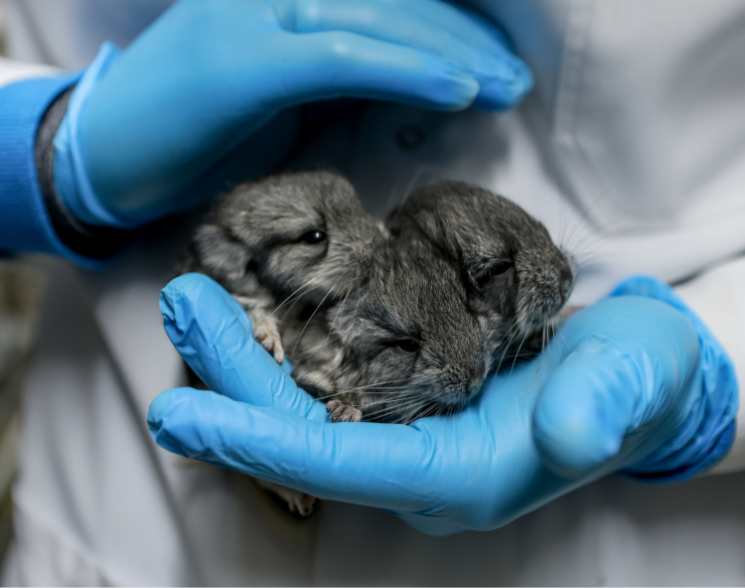
Chinchillas, although adapted to captive life, can suffer from various conditions that may impact their health and fur quality. Early identification and proper management of diseases are essential for maintaining a healthy colony.
Chinchilla ailments can manifest externally, affecting the fur and skin, as well as internally, impacting the health of organs.
Gastrointestinal Issues: Moldy or low-quality food can cause digestive problems, with chinchillas showing symptoms like soft stools, gas, and discomfort.
Treatment: Administer boiled rice water, roasted rice, or boiled carrots. In cases of constipation, give paraffin oil or carefully perform an enema.
Hair loss can be caused by an inadequate diet lacking in vitamins. The fur may begin to fall out in small areas but can spread across the entire body. The animal becomes restless and may pull out its own fur. In advanced cases, the skin develops eczema and ulcers.
Treatment: Chinchillas are given seeds rich in natural oils (hemp, flax), and the fur is gently massaged. Areas affected by eczema are treated with ointments.
Hair Chewing: Due to vitamin deficiencies or improper conditions (humidity below 60%, temperatures above 18°C), chinchillas may start chewing their own fur or that of their cage mates. This behavior can also result from stress.
Treatment: The animals are isolated, fed vitamin-rich foods (fruits, carrots), and exposed to sunlight at a temperature of 18°C.
Fungal Infections (Ringworm): Chinchilla fur can be affected by fungi, which develop due to improper diet and hygiene. The skin shows small hairless spots that can spread and become purulent.
Treatment: The animal is isolated, and the cage is disinfected. The affected fur is cleaned and treated with antifungal ointments.
Respiratory Infections: Drafts and temperature fluctuations can cause respiratory illnesses. Symptoms include coughing, sneezing, and lethargy.
Treatment: Maintain a constant temperature of 18°C.
Reproductive Issues: Poor nutrition and lack of exercise can lead to sterility. Infertile females are culled, while males with persistent infertility are given supplements and vitamins.
Selection and Sorting of Chinchilla Fur
Chinchilla Fur Classification by Size and Quality
Chinchilla furs are classified by size and quality to ensure uniform standards and high-value products.
Fur Quality Categories:
Select (high quality) – High-quality fur, without defects, large size, excellent contrast, and clear oval shape.
First Class (very good quality) – Very good quality fur, with minor acceptable imperfections.
Second Class (good quality) – Medium-quality fur, with more noticeable defects.
Mixed (low quality) – Low-quality fur, with uneven sizes and characteristics.
Classification Table
| Size (cm) | Quality Class | Description | International Classification |
|---|---|---|---|
| 45+ | XXD | Extra Large | 40 |
| 43–45 | XD | Large | 30 |
| 41–42 | D | Good Size | 00 |
| 39–40 | A | Medium | 0 |
| 37–38 | B | Small | 1 |
| <36 | C | Very Small | 2 |
Note: The classification refers exclusively to size and is separate from other factors such as color, density, luster, or fur cleanliness.
The main objective of chinchilla breeding is to obtain high-quality fur at minimal production costs to maximize profit. The key factors influencing fur quality are heredity, careful selection of breeders, and microclimate conditions.
1. Genetic Factors
Genetics play a key role in determining the quality of chinchilla fur. Well-selected genetic lines can produce dense, uniform fur with fine texture and natural shine. Selective breeding of chinchillas with superior genetic traits, such as fur density, uniform color, and resilience, is standard practice on top farms. To prevent genetic problems, it is essential to avoid inbreeding while maintaining genetic diversity within the population.
2. Nutrition
A balanced diet tailored to the needs of chinchillas is fundamental for the development of healthy and shiny fur. Feeds rich in fiber, vitamins, and minerals, combined with quality supplements, support hair growth and regeneration. Clean and constantly accessible water is also essential for maintaining the animals' overall health.
3. Environmental Conditions
The environment in which chinchillas are raised has a direct impact on fur quality. Environmental factors that significantly influence quality include:
Temperature: The ideal temperature range for chinchillas is between 10°C and 22°C. Extreme temperatures can cause heat stress, negatively affecting fur quality.
Humidity: Optimal humidity levels range between 40% and 60%. Excessive or low humidity can deteriorate fur texture and density.
Ventilation: Proper ventilation prevents the buildup of dust and unpleasant odors, which can impact both animal health and fur quality.
Hygiene: A clean and well-maintained environment reduces the risk of infections or skin diseases, which could negatively affect the fur.
4. Sand Baths
Chinchillas require regular baths in fine sand to keep their fur clean, healthy, and shiny. Special sand removes excess oils and impurities, preventing the buildup of dirt that could damage fur texture and appearance.
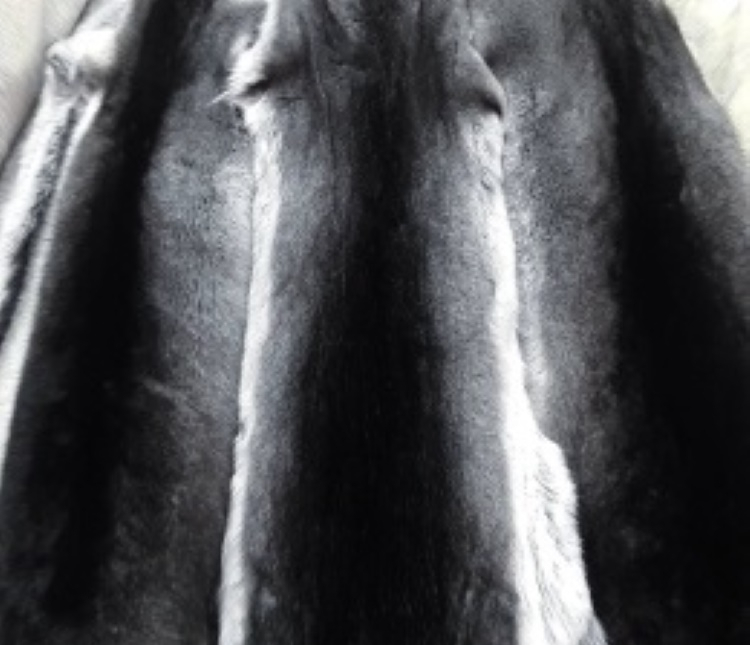

Income Sources from Chinchilla Breeding
Chinchilla breeding is a profitable and enjoyable activity, suitable both as a business and as a hobby. In recent years, this occupation has gained increased popularity in the Republic of Moldova, with many people turning to establish chinchilla farms.
There are two main uses for chinchillas:
- Fur animal: Chinchilla fur is highly valued and in high demand on both domestic and international markets. Prices range from €60 to €200.
- Pet: Chinchillas as pets are sold in specialty stores at prices ranging from 700 to 1500 MDL.
Both options are profitable and can be pursued simultaneously.
Advantages of Chinchilla Farming
- Minimal space requirements: A room of 15-20 square meters is sufficient for several chinchilla families.
- Ease of starting the business: No specialist knowledge is required. With the correct information and determination, anyone can succeed in this business.
- Adaptability to various environments: Chinchillas can be bred both in urban and rural settings.
- Low maintenance time: Chinchilla care is not time-intensive, making it suitable for different lifestyles.
- Cleanliness and hygiene: Chinchillas are clean and low-maintenance animals. However, as nocturnal creatures sensitive to noise, it is important to ensure they have peace during the day.
Chinchilla breeding can become a profitable and flexible business, suitable for both urban and rural areas, while also offering personal satisfaction to animal enthusiasts.












